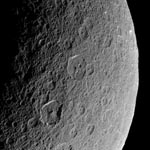Cassini pinpoints source of jets on Saturn’s moon Enceladus

Washington, Oct 11 : The NASA/ESA/ASI Cassini spacecraft has provided conclusive evidence that jets of fine, icy particles spraying from Saturn's moon Enceladus originate from the hottest spots on the moon's “tiger stripe” fractures that straddle the satellite’s south polar region.
The Cassini imaging team used two years' worth of pictures of the geologically active moon to locate the sources of the most prominent jets spouting from the moon's surface.
They then compared these surface source locations to hot spots detected by Cassini on Enceladus in 2005.
The astronomers found that all of the jets appeared to come from the four prominent tiger stripe fractures on the moon's active south polar region, and in almost every case, in the hottest areas detected by Cassini's composite and infrared spectrometer.
This is the first time the visible jets have been tied directly to the tiger stripes,” said Joseph Spitale, an imaging team associate and lead author of the study in the October 11 issue of Nature.
Previously, imaging scientists suspected that the individual jets, which collectively fed a plume that towered thousands of kilometres, or miles, above the moon, had been coming from the tiger stripes since the first images of the jets were taken in 2005.
But this recent study has provided the first conclusive proof of that hypothesis, as well as the first direct evidence of a causal connection between the jets and the unusual heat radiating from the fractures.
To identify the jets' surface locations with certainty, the researchers carefully measured the apparent position and orientation of each jet as observed along the moon's edge by the spacecraft.
By making measurements taken from a variety of viewing directions, they were able to pinpoint the jets' sources.
What Spitale and co-researcher Carolyn Porco found was that all measured jets fell on a fracture, but not all jets fell on a previously discovered hot spot.
The scientists conclude there are other hot spots to be found, as well.
“Some of our sources occur in regions not yet observed by Cassini's composite infrared spectrometer. So we are predicting that future Cassini observations of those locations will find elevated temperatures,” said Spitale.
The scientists further said that the characteristics of the jets could depend on tidal frictional heating within the fractures and its variation over a full Enceladus orbit around Saturn.
However, more work would be required in investigating this issue, said Spitale.
“These are findings with tremendously exciting implications and to say that I am eager to get to the bottom of it would be a cosmic understatement,” said Porco.
“Do the jets derive from near-surface liquid water or not? And if not, then how far down is the liquid water that we all suspect resides within this moon? Personally, I'd like to know the answer yesterday!” she said.
Porco said the next opportunity for answering these questions will be when Cassini dips low over Enceladus and flies through the plume in March 2008, obtaining additional data about its chemical composition and the nature of its jets. (ANI)
